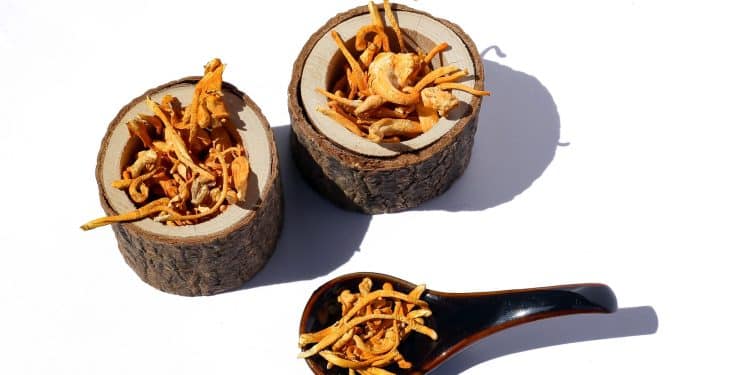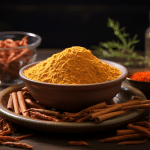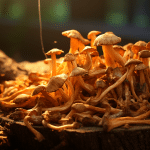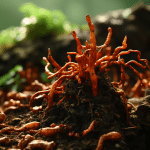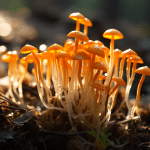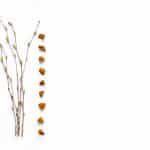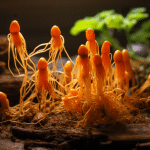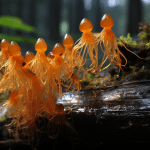Candidiasis is a fungal infection caused by the fungus Candida, especially Candida albicans. These fungi usually colonize your mouth, and digestive tract. Candida is well-managed by the body’s immune defenses.
When the balance of the resident bacteria is disrupted and the immune system is compromised, yeast infections begin to flourish and produce various symptoms. Typically, a yeast infection, Candida, will attack your mouth, genital areas, or skin. People who have a compromised immune system, which results from a chronic illness, or medications including corticosteroids or anticancer drugs, are more vulnerable to surface infections, and are more likely to have a more severe fungal infection or allergic reaction.
Does Cordyceps Mushroom Cure Candida?
According to studies, cordyceps mushroom does help alleviate candida infections within the body. You can see via this study, and this study, that the candida fungal infections were significantly inhibited with the use of cordycepin, one of the active compounds of cordyceps mushrooms.
It seems counter-intuitive that a fungal infection can be fought off using a fungus, but the science speaks for itself. I personally found relief from candida from taking a cordyceps supplement. But powders and tinctures also contain cordycepin, and tinctures are usually seen as the most potent form of taking any supplement.
You can find our favorite capsules, powders, and tincture’s on the following pages of our website and learn more about each individually:
Best Cordyceps Mushroom Gummies
Here’s a video that discusses the role of functional mushrooms and how they can help with candida in more detail:
What parts of the body can be affected by candida?
Thrush is a common name for an oral infection caused by the Candida albicans fungus, which attacks the moist surfaces surrounding your lips, on your tongue, on your palate, and within your cheeks. Esophagitis is when a candida infection has spread from the mouth into the oesophagus. Cutaneous (skin) candidiasis is when The candidas may cause infections on the skin of places like diaper areas, scabs on the ridges of skin on the bases of fingernails, particularly in hands exposed to moisture; hands of persons who regularly wear rubber gloves; areas around the groin and creases in the glutes; the skin folded underneath the large breasts, if there is moisture.
Genital yeast infections are generally considered to not be sexually transmitted. About 75% of women are most likely to have genital yeast infections at least once in their lifetime. Women who are pregnant or taking birth control, and women who have diabetes or are taking antibiotics are all more likely to get a fungal infection.
Deep Candida infections (such as Candida sepsis) means the Candida has found a way to enter your bloodstream and has spread through your entire body, leading to severe infections. This typically happens to people who have a seriously compromised immune system due to an illness or medications, like anticancer drugs. In such cases, a fungus may have entered the bloodstream via surgical wounds, catheters, tracheostomy tubes, ventilator tubes, serious burns, IV drug injections, injury wounds, or other means.
What are the symptoms of a Candida infection?
Thrush is white, curd-like patches that develop inside of your mouth, particularly your tongue, your palate, and around your lips, as well as cracked, red, moist areas of skin at the corners of your mouth. Esophagitis is when it can make swallowing difficult or painful, and it can also make your chest hurt behind your sternum. Cutaneous candidiasis is when The fungal infection of cutaneous areas may result in red, wet, sticky skin, and small pustules.
Deep-seated candidiasis is the more dangerous condition, because Candida infections move to the bloodstream. This can result in a wide array of worrying symptoms, such as fever, shock, and several organ failures.
What can be done to prevent candida infections from occurring?
Keep the skin clean and dry. Stick to a diet of healthful foods, including vegetables, fruits, and berries. Take antibiotics only when prescribed by a healthcare provider, and as directed.
Keep blood sugar levels in check. Maintain a healthy lifestyle and include physical activity. I personally supplement the main adaptogenic mushrooms, including cordyceps, each day, and I haven’t had any issues with candida, or it’s cousin, tinea, ever since.
Additional Resources:
Does Cordyceps Help With Blood Pressure?
Does Cordyceps Help with COPD?
Updated 10/14/2022
